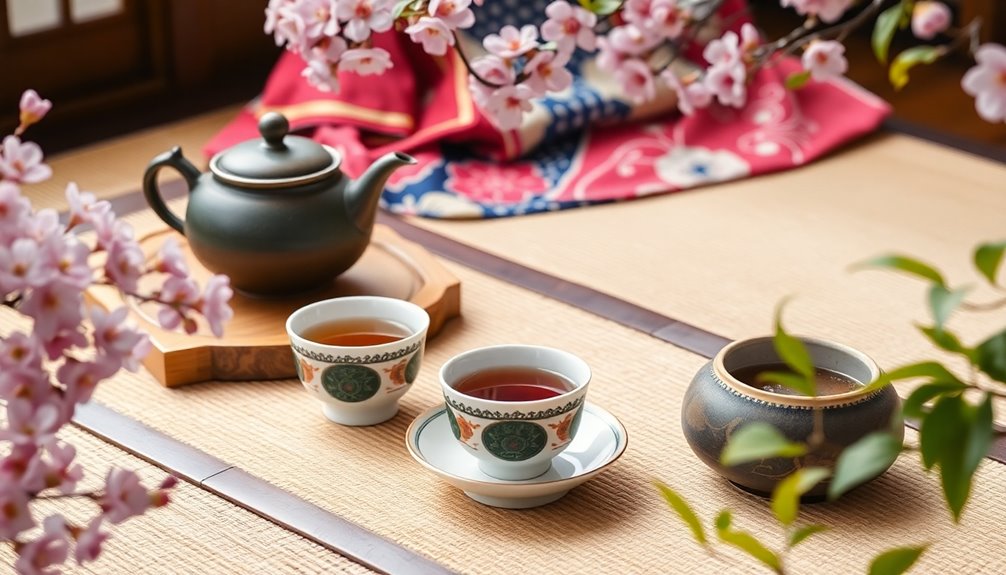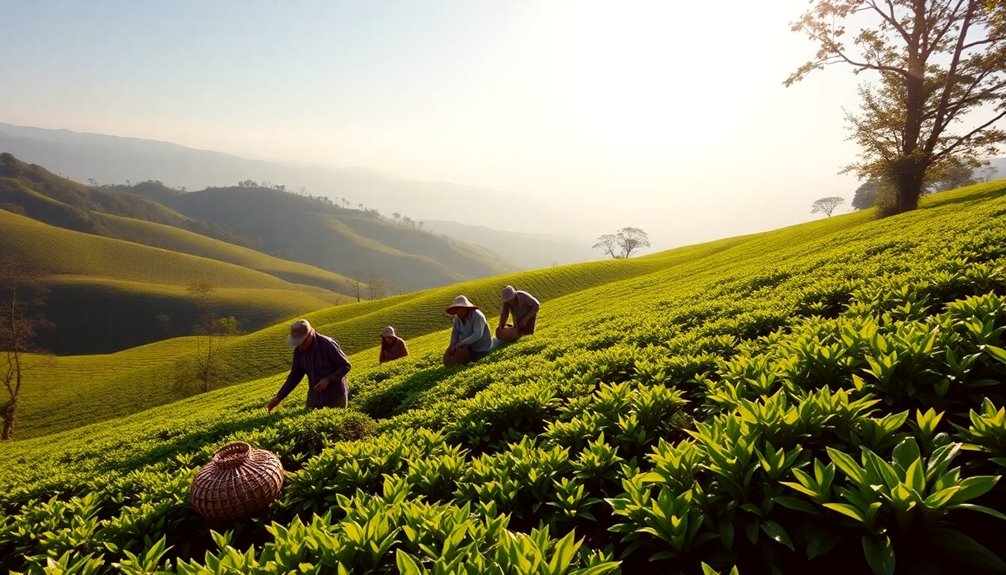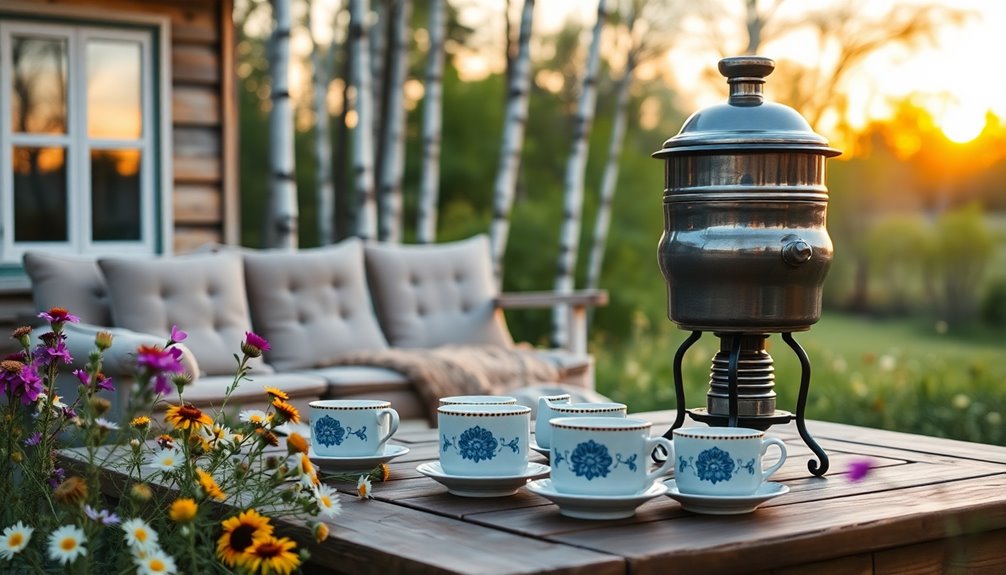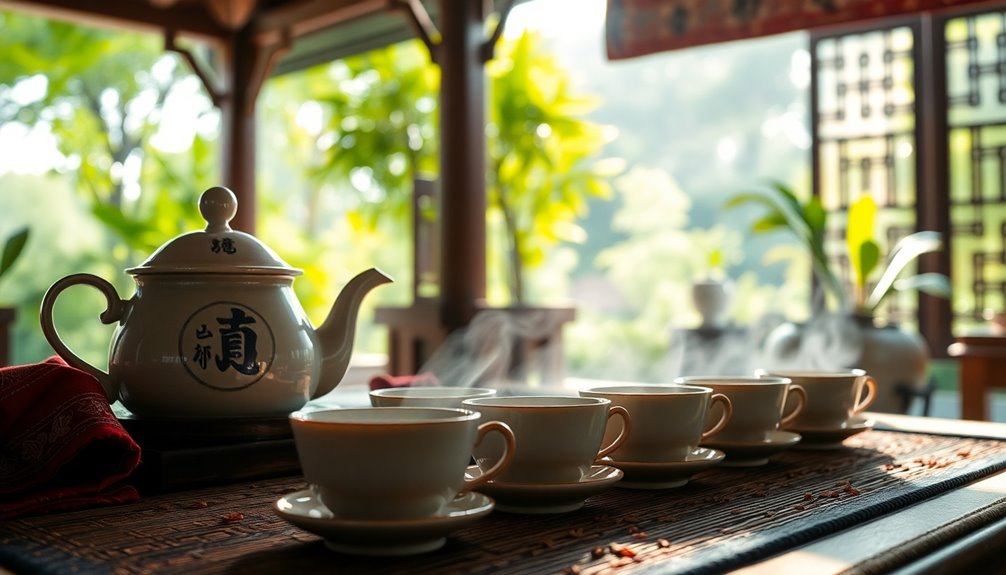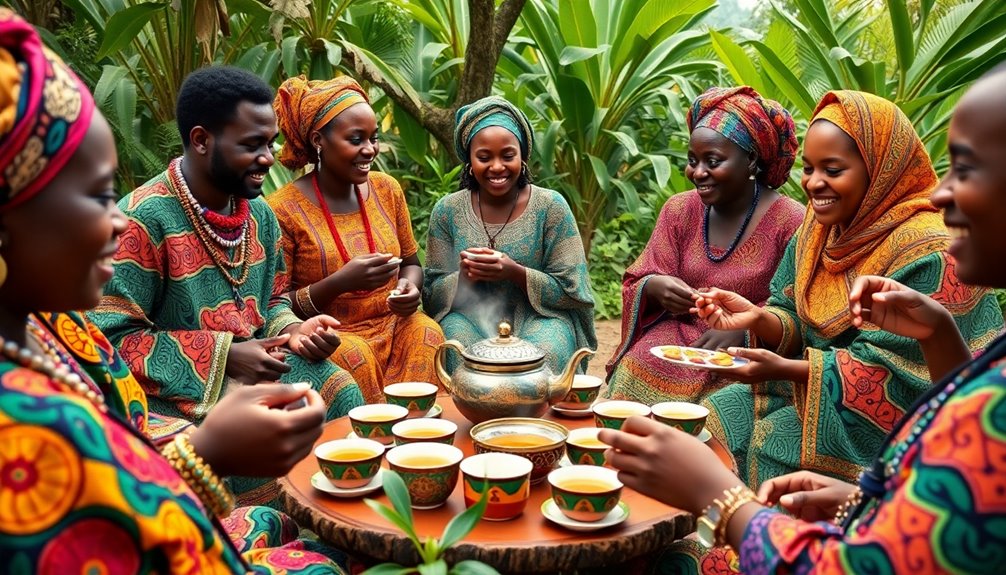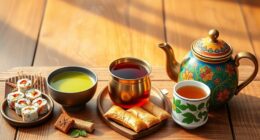Tea serves as a powerful social symbol in Japanese and Korean cultures, representing hospitality and respect. In Japan, the tea ceremony, or chanoyu, focuses on harmony and mindfulness. Similarly, Korea's tea offerings, like sanghwacha and yujacha, promote health and social bonding. Sharing tea fosters connections between people and communities, making it an important part of festive gatherings. Historically, tea also reflects social hierarchy, with certain types signifying wealth and status. The beauty of tea rituals has inspired art, celebrating these traditions. If you're curious about how tea shapes relationships and culture, there's plenty more to explore!
Key Takeaways
- Tea represents hospitality and respect in Japanese and Korean cultures, reinforcing social bonds during gatherings and ceremonies.
- The Japanese tea ceremony (chanoyu) and Korean darye emphasize mindfulness, respect, and meaningful exchanges between participants.
- High-quality tea consumption historically signifies wealth and social status, reflecting the economic structures of Japan and Korea.
- Tea rituals enhance cultural identity and artistic expression, connecting individuals through shared aesthetics and communal experiences.
- Cultural appropriation debates highlight the importance of understanding traditional tea practices to preserve their authenticity and significance.
Introduction

Tea plays a vital role in the social fabric of both Japanese and Korean cultures, acting as a powerful symbol of hospitality and respect.
In Japan, the Japanese tea ceremony, known as chanoyu, showcases meticulous attention to detail. It reflects principles like harmony, respect, purity, and tranquility, all important in social interactions. When you're offered green tea at a gathering, it's more than just a drink; it's a warm welcome.
In Korea, tea culture also emphasizes hospitality. Offering tea to guests is a cherished tradition. Varieties like sanghwacha and yujacha aren't only tasty but also highlight health benefits, enhancing connections among friends and family.
Both cultures incorporate tea into their culinary practices. In Japan, tea often accompanies meals, while in Korea, tea is usually served for free as a gesture of kindness.
The preparation and enjoyment of tea involve a ritual that reinforces cultural identity.
Tea as a Cultural Bridge
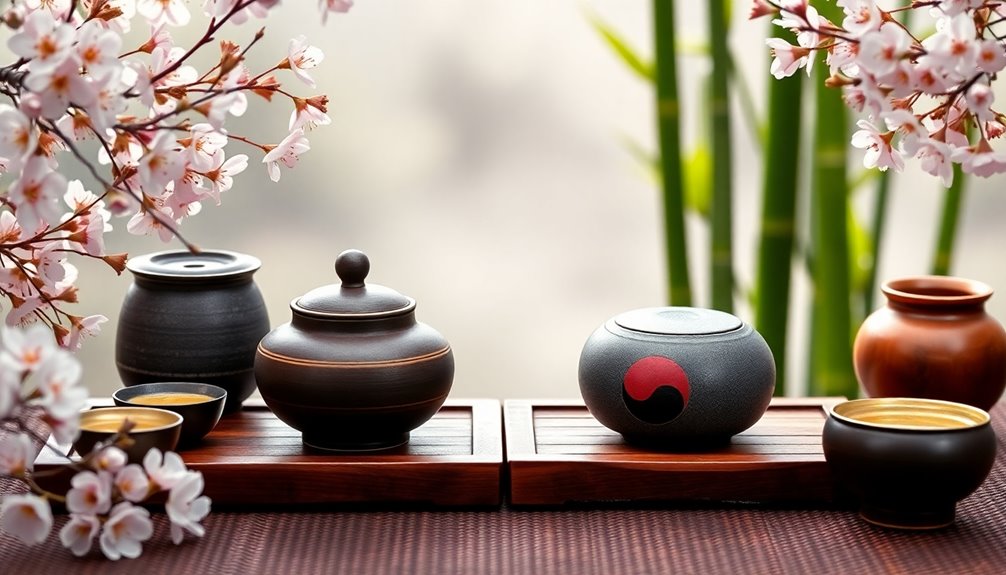
In both Japan and Korea, the ritual of serving tea acts as a cultural bridge, fostering connections that transcend mere hospitality. The tea ceremony, whether it's Japan's chanoyu or Korea's darye, emphasizes mindfulness and respect. These ceremonies create a space where social gatherings thrive, allowing friends and family to connect deeply.
In Japan, the significance of serving tea highlights cultural heritage and reinforces communal ties. When you participate in a tea ceremony, you're not just enjoying a drink; you're engaging in a meaningful exchange.
Similarly, in Korea, the relaxed atmosphere of darye encourages ease and naturalness, making conversations flow effortlessly. This ease strengthens interpersonal relationships and deepens bonds among participants.
Both cultures share a love for tea, making it a powerful tool for cultural exchange. By appreciating each other's tea traditions, you help bridge gaps and foster understanding between Japan and Korea.
Tea's Role in Social Hierarchy
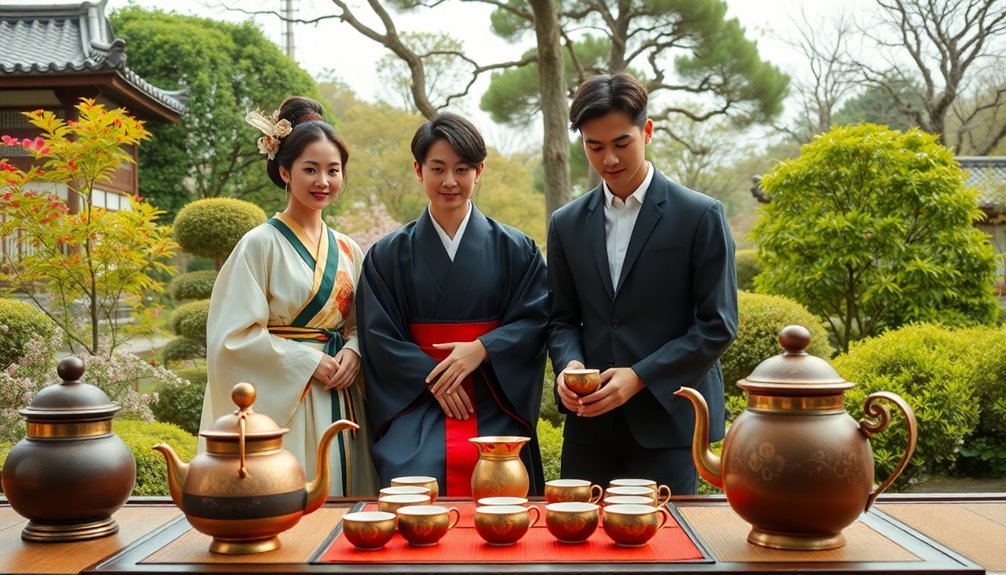
Moreover, the introduction of tea cultivation in Japan and Korea connected tea with wealth and power.
Access to high-quality teas became a marker of elite status.
Tea's Influence on Artistry
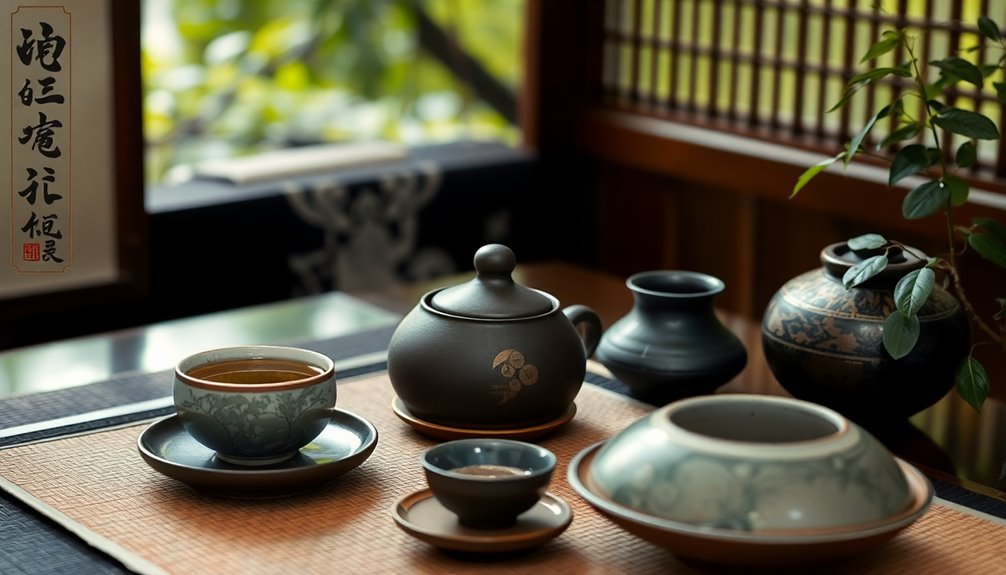
As you explore these traditions, you'll see how tea gatherings are depicted in historical texts and artworks.
These pieces celebrate the importance of aesthetic presentation and social interaction, showcasing how tea connects people through artistry.
Cultural Appropriation Debates
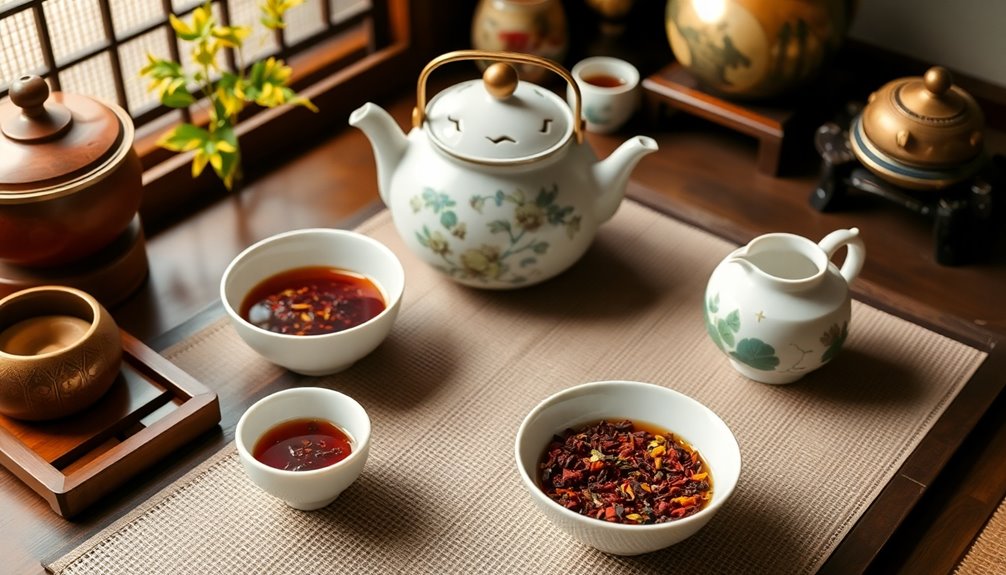
While enjoying a cup of tea, you might find yourself reflecting on the complex conversations surrounding cultural appropriation in Japanese and Korean tea practices.
These discussions often arise from the long history between Japan, Korea, and China. Each country has its unique tea ceremony, like the Japanese tea ceremony, chanoyu, and the Korean tea ceremony, darye.
When elements of these ceremonies are borrowed or commercialized, it can sometimes feel disrespectful. For instance, matcha lattes in cafes might make the traditional practices seem less authentic. Critics argue that this commercialization can dilute the spiritual significance and cultural heritage of these tea practices.
It's important to understand the historical contexts from which these traditions emerge. Respecting the rituals and etiquette inherent in both Japanese and Korean tea ceremonies is crucial.
When you engage with these practices, consider the deeper meanings behind them. By acknowledging their cultural roots, you can appreciate the authenticity of the experiences. Enjoying tea isn't just about the drink; it's also about understanding and respecting the rich traditions that have shaped it over generations.
Practical Applications
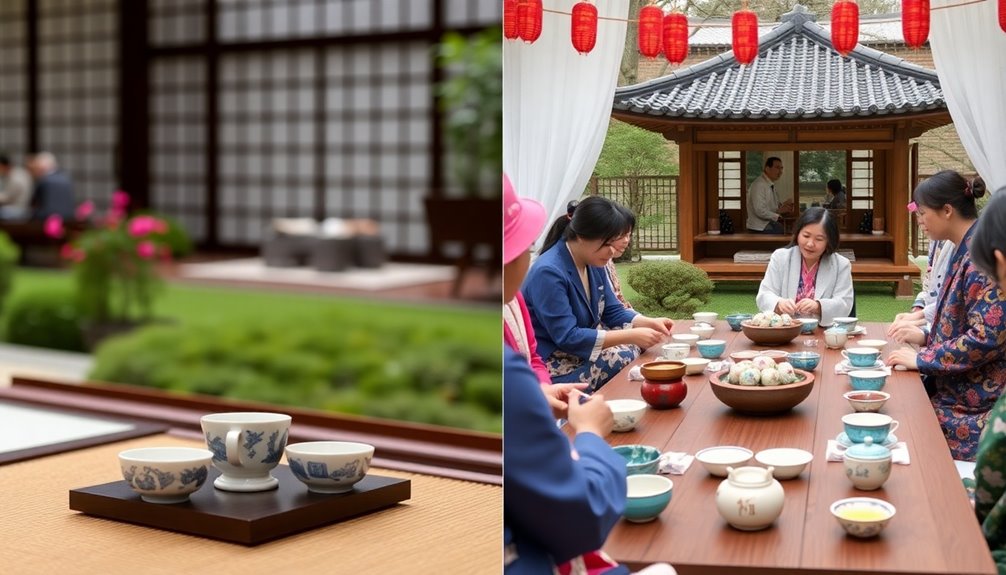
Often, when you participate in a tea ceremony, you'll find that the experience goes beyond just sipping tea; it's a chance to connect with others in a meaningful way.
In Japanese culture, the tea ceremony (chanoyu) emphasizes harmony and respect, making it a perfect moment for community bonding. You'll notice how the aesthetic presentation of the tea, from the choice of utensils to the serene setting, helps create a special atmosphere.
In Korean tea culture, the darye ceremony promotes ease in conversation, encouraging relaxation among friends and family.
When you visit a Korean tea shop, known as a daehak, it becomes a social hub where people gather, sharing experiences over a variety of teas. Here, serving tea is more than a gesture; it's a sign of hospitality, welcoming everyone to enjoy the moment together.
Herbal teas, such as peppermint tea, can also enhance the social experience by providing comfort and relaxation during these gatherings.
Whether you're partaking in a traditional tea ceremony or visiting a cozy tea shop, these practices highlight tea as a social symbol, fostering connections and shared memories.
Frequently Asked Questions
What Does Tea Symbolize in Japanese Culture?
In Japanese culture, tea symbolizes harmony and respect. You'll find that through the tea ceremony, it's all about mindfulness and attentiveness, showcasing beauty in simplicity while fostering connections among participants in a tranquil atmosphere.
What Is the Social Significance of the Japanese Tea Ceremony?
The Japanese tea ceremony fosters connection and communication among participants. You share a serene space, embracing mindfulness and appreciation, transforming a simple act into a profound cultural experience that enhances relationships and deepens your understanding of harmony.
What Is the Social Significance of Tea?
Tea's social significance lies in its ability to bring people together. You share conversations, create connections, and foster community. It acts as a bridge, enhancing relationships and providing comfort in both casual and formal settings.
Why Is Tea so Important in Korea?
Tea's important in Korea because it embodies hospitality, respect, and social connection. You'll find unique flavors and traditions that enhance gatherings, promote health, and foster creativity, making each tea experience a cherished part of life.
Conclusion
In conclusion, tea isn't just a drink; it's a special part of Japanese and Korean cultures. It connects people, shows respect in social settings, and inspires beautiful art. As you explore these traditions, remember to appreciate the meaning behind each cup. Whether you're enjoying a tea ceremony or sharing a simple cup with friends, you're taking part in a rich history. So, pour yourself some tea, and enjoy the warmth it brings to your life!

